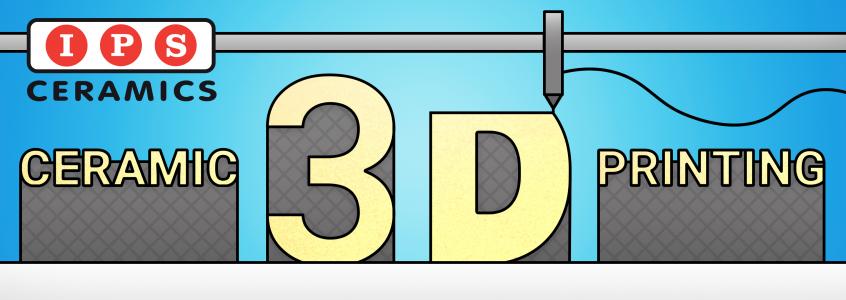Blog

How 3D Printed Ceramics Are Made
Posted by Tom Evans on August 19, 2022
3D printing is quickly becoming the preferred manufacturing process for customers seeking small quantities of ceramic shapes with complex designs but still excellent results. Using CAD software and specialist technology, 3D printers allow you to produce ceramic shapes that have complicated designs with tiny features that would be unachievable through other methods, are more economical to produce in lower quantities, and are simpler to change and update the designs over time.
IPS Ceramics provides bespoke 3D printed pieces (amongst many other ranges). Similar to typical plastic 3D printing, there are many different methods which can be used to 3D print ceramic materials. Each one offers different benefits and choosing which method best suits your requirements should be done with the utmost care and attention.
Method 1: Paste Extrusion
This form of 3D ceramic printing is currently the most common; however, it is typically only used with clay-based ceramics. Ceramic powder is mixed with a binder to form a thick paste. This paste is then extruded through one of two types of 3D machines: the first has a static nozzle head and a base which moves to form the shape, the other a fixed base and a nozzle which moves. The paste is extruded in a string-like formation, resembling the hand-coiling method of craft pottery.
The higher build rate of this method allows for larger pieces to be created with a limited risk of deformation.
Method 2: Binder Jetting
During the binder jetting process, a layer of ceramic powder is laid down and a binding solution is jetted onto it. Another layer of powder is then laid down over the solution, then another layer of binding solution is jetted on top of it, and so on. This process slowly builds up the final product layer by layer, creating the final 3D design. Once any excess powder has been removed, the finished piece is then fired to complete the production process.
This method uses one of the largest bases, allowing its users to produce relatively large pieces.
Method 3: Photo Polymerization
For photopolymerization 3D printing, ceramic powder is combined with a liquid resin. This combination allows the mixture to be hardened layer-by-layer using either a laser light source or a digital projector.
Unlike other 3D printing options, this method allows for detail of fewer than 100 nanometers, ideal for intricate and precise ceramic printing.
Method 4: Nano-Particle Jetting
Nano-particle jetting, considered to be similar to inkjet printing, is a process in which nanoparticles of ceramic are suspended in a liquid and jetted onto a heated base alongside a support material. The heated base evaporates any excess liquid, leaving the ceramic material ready to be fired and finished.
Method 5: Laser Sintering
Laser sintering, also known as selective laser sintering, is an additive manufacturing technology which uses a high-powered laser to sinter nanoparticles of ceramic powder into a 3D model. This form of 3D printing is completed inside of a build chamber. The bed on which the powder is dispensed lowers with each level that has been lasered. The surrounding powder acts as a support to the final structure of the piece until the final structure is cooled and removed from the chamber.
Finishing Processes
Unlike 3D printed plastics, 3D printed ceramics require further processing to ensure that they are finished and ready for use. Firstly, many of the printing methods require the removal of excess ceramic powder from the piece. The method of removal will greatly depend on the structure of the piece, the amount of excess powder and the specific requirements for the finished structure.
The product will then move to the de-binding stage. In this stage, any organic binders used are slowly removed by heating the piece to about 500oC in a furnace over a period of 24-48 hours. The slow process minimises the risk of damaging the still rather fragile product.
After the de-binding process, the product will immediately go through a sintering process, which will raise the temperature to 1200oC or higher. At these high temperatures, small portions of the ceramic melt to form a liquid (and atoms become energetic enough to move), drawing the ceramic particles together. As the piece changes from a weekly held collection of particles into a strong, solid item, there is often significant shrinkage in size.
Finally, the piece goes through a cleaning process in which any imperfections can be noted and addressed. This can include polishing of the finished item, should it be required.
Contact Us
Ceramic 3D printing, while not an entirely new industry, is still one that is being heavily experimented with. New techniques and uses for it are being developed all the time. If you or your business would like any further information on 3D ceramic printing from IPS Ceramics, please contact the team today who will be happy to discuss this with you.
IPS ceramics supply all manner of high-quality ceramic-based products and services, whether you are looking for kiln furniture, silicon carbide, or ceramics for EV batteries, we can help you. We service many areas all around the globe, including the USA, so what are you waiting for? Please contact us today.
